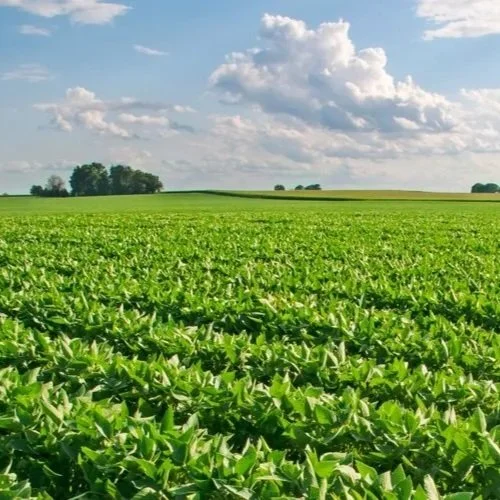In the year ahead, the United Soybean Board (USB) will boost demand for U.S. Soy, drive on-farm resilience and bring value to the nearly half a million U.S. soybean farmers. Led by its 77 farmer-leaders, USB recently approved a $121.3 million budget for the 2026 fiscal year, strategically allocating funds across vital research, promotion and education investments. This spans the food, feed, fuel, industrial, exports and sustainable production market segments.
Read MoreThis month’s 2025/26 U.S. corn outlook calls for smaller supplies, domestic use, and ending stocks. USDA cut corn beginning stocks by 25 million bushels to 1.3 billion, reflecting an increase in exports that is partly offset by lower feed and residual use for 2024/25. Feed and residual use is down 75 million based on indicated disappearance in the June 30th Grain Stocks report. Exports are raised 100 million bushels to 2.8 billion based on current outstanding sales and shipments to date and, if realized, would be record high.
Read MoreFor decades cotton was king. But this year the Louisiana cotton crop is expected to be the smallest in history. State Agriculture Commissioner Mike Strain says input costs to produce cotton has gone up and the price farmers can get for cotton has gone down from two dollars a pound in the mid-1800s.
Read MoreIn its latest Crop Progress report, the USDA rated 75% or more of the soybean crop in four of the top 18 soybean-growing states good/excellent.
USDA rated 87% of Louisiana’s crop good/excellent, the highest percentage of all top soybean-growing states. What’s more: Just 13% of the state’s crop were rated fair, and none were rated poor or very poor.
Read MoreEffects from record low levels on the Mississippi River could’ve reduced the value of Arkansas’ 2022 soybean crop up to $293 million, according to research by two agricultural economists with the University of Arkansas System Division of Agriculture.
Read MoreDave Walton, secretary of the American Soybean Association and a farmer from Wilton, Iowa, testified today before the House Agriculture Committee’s Subcommittee on General Farm Commodities, Risk Management and Credit, emphasizing the importance of reauthorizing the U.S. Grain Standards Act. Under the Grain Standards Act, the federal government established official marketing standards (not health and safety standards) for grains and oilseeds, which are overseen by the Federal Grain Inspection Service (FGIS).
Read MoreThe USDA said that as of June 15, 93% of the soybean crop across the top soybean-growing states had been planted. The five-year average is 94%.
Louisiana and Minnesota both reached 100% by June 15. They are the first of the top states to wrap up soybean planting.
Read MoreThe 2025 soybean planting season in Louisiana began rapidly, with 70%-80% of the projected acres planted by May 1, significantly exceeding the average of 40%-50%. Although most of the crop was planted within the optimal window, heavy rainfall and strong winds have led to issues such as failed stands and delayed weed control applications.
Read MoreCommon rust may be the first disease found in corn fields and usually occurs in the lower-to-mid-canopy. Pustules of common rust are brick red to dark orange, somewhat elongated, and will appear on both leaf surfaces (Figure 1).Common rust will progress during relatively cool temperatures (60-75oF) combined with rainy weather or heavy dews (6 hours of leaf wetness), and cloudy weather; however, very rarely are fungicide applications warranted for common rust. Warmer temperatures (> 80oF) will greatly slow common rust development.
Read MoreCrop nutrients are typically applied at planting. However, in-season foliar applications have demonstrated yield increases in both cotton and soybeans throughout the southern U.S. in research conducted by AgroLiquid.
On-farm trial work is ongoing in parts of the Midsouth, Southeast, and in Texas. This work is through a partnership between AgroLiquid and Southern Ag Services, headquartered in Starkville, Miss., along with cooperating farmers across the region.
Read MoreThis guide provides a general overview of the common insect pests affecting soybean crops in Louisiana. It includes descriptions of each pest’s life cycle, morphological characteristics, feeding behavior, and the damage they cause to soybean plants. The guide also offers visual identification tips.
Read MoreConsuming soybeans can greatly reduce the risk of cardiovascular disease, stroke, and heart disease.
St. Francis Medical Group Nutritionist Jen Avis stopped by Good Morning ArkLaMiss to discuss the benefits of eating soybeans.
According to Healthline, soybeans are one of the best sources of plant-based protein.
Read MoreThe 2025/26 U.S. corn outlook is for record supplies and total use, and higher ending stocks. The corn crop is projected at 15.8 billion bushels, up 6 percent from a year ago on increases to both area and yield. Planted area of 95.3 million acres if realized would be the highest in over a decade. The yield projection of 181.0 bushels per acre is based on a weather-adjusted trend assuming normal planting progress and summer growing season weather.
Read MoreThe 2025 soybean planting season in Louisiana began favorably, with 80% of the crop planted by May 4th, significantly ahead of the 5-year average of 54%. However, recent heavy rainfall has introduced concerns. Late April storms caused flooding in some fields, necessitating replanting in certain areas.
Read MoreLouisiana soybean planting is running well ahead of schedule, mainly because of good weather and partly because this year’s crop is smaller. LSU AgCenter reporter Craig Gautreaux has the story from northeast Louisiana.
Read More













